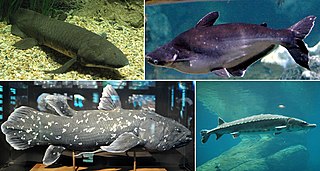
Osteichthyes, also known as osteichthyans or commonly referred to as the bony fish, is a diverse superclass of vertebrate animals that have endoskeletons primarily composed of bone tissue. They can be contrasted with the Chondrichthyes and the extinct placoderms and acanthodians, which have endoskeletons primarily composed of cartilage. The vast majority of extant fish are members of Osteichthyes, being an extremely diverse and abundant group consisting of 45 orders, over 435 families and 28,000 species. It is the largest class of vertebrates in existence today, encompassing most aquatic vertebrates, as well as all semi-aquatic and terrestrial vertebrates.

The butterflyfish are a group of conspicuous tropical marine fish of the family Chaetodontidae; the bannerfish and coralfish are also included in this group. The approximately 129 species in 12 genera are found mostly on the reefs of the Atlantic, Indian, and Pacific Oceans. A number of species pairs occur in the Indian and Pacific Oceans, members of the huge genus Chaetodon.

Tilefishes are mostly small perciform marine fish comprising the family Malacanthidae. They are usually found in sandy areas, especially near coral reefs. They have a long life span, up to 46 years (females) and 39 years (males).

Caproidae, or boarfishes, are a small family of marine fishes comprising two genera and 19 species. These fishes are found throughout the world in temperate and tropical seas.

Antigonia is a genus of marine ray-finned fish belonging to the family Caproidae, the boarfishes. This genus is found in the warmer oceans around the world and is the only extant genus in the subfamily Antigoniinae.

The Synodontidae or lizardfishes are benthic (bottom-dwelling) marine and estuarine bony fishes that belong to the aulopiform fish order, a diverse group of marine ray-finned fish consisting of some 15 extant and several prehistoric families. They are found in tropical and subtropical marine waters throughout the world.

Slickheads, also known as nakedheads or smoothheads, are deep water fishes that belong to the family Alepocephalidae. They are most commonly found in the bathypelagic layer, which is approximately 3000m below the surface. They get their name from the lack of scales on their heads. Similarly, the scientific name is from the Greek ᾰ̓- (a-, "not"); λέπος (lepos, "scale"); and κεφαλή (kephalē, "head"). It has about 22 genera with ca. 96 species.
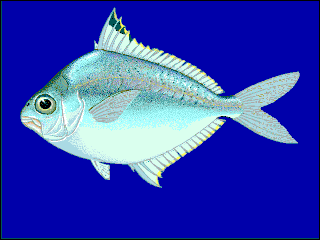
Leiognathidae, the ponyfishes, slipmouths or slimys / slimies, are a small family of fishes in the order Perciformes. They inhabit marine and brackish waters in the Indian and West Pacific Oceans. They can be used in the preparation of bagoong.

The variegated lizardfish is a lizardfish of the family Synodontidae found in the western Pacific and Indian Oceans, at depths from 4 to 90 m. It can reach a maximum length of 40 cm.

Cathorops is a genus of catfishes in the family Ariidae found in the Atlantic and Pacific Oceans. These species are found in the eastern and western Central and South America in brackish and freshwater habitats. This genus is a strongly supported clade of this family. It consists of a natural group in which the monophyly is well-defined by morphological and molecular evidence and the genus probably includes several unrecognized species from both American coasts.

Eptatretus is a large genus of hagfish.
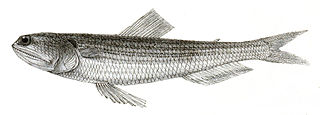
Trachinocephalus myops, the blunt-nose lizardfish, is a species of fish in the family Synodontidae found in Atlantic Ocean. This species grows to a length of 40 centimetres (16 in) TL. It has been discovered that the species has two peaks in its spawning season, from February to April and from August to October. This suggests that their reproductive activity is suitable for the different environments the species utilizes.

The Gobiiformes are an order of fish that includes the gobies and their relatives. The order, which was previously considered a suborder of Perciformes, is made up of about 2,211 species that are divided between seven families. Phylogenetic relationships of the Gobiiformes have been elucidated using molecular data. Gobiiforms are primarily small species that live in marine water, but roughly 10% of these species inhabit fresh water. This order is composed chiefly of benthic or burrowing species; like many other benthic fishes, most gobiiforms do not have a gas bladder or any other means of controlling their buoyancy in water, so they must spend most of their time on or near the bottom. Gobiiformes means "goby-like".
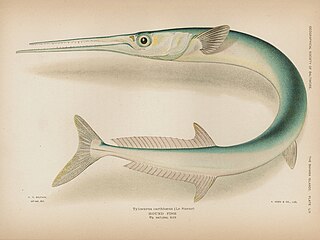
The houndfish is a game fish of the family Belonidae. It is the largest member of its family, growing up to 5 feet (1.5 m) in length and 10 pounds (4.5 kg) in weight. It is also often called the crocodile needlefish.

Synodus intermedius, the common sand diver, is a species of fish in the lizardfish family, the Synodontidae, a basal ray-finned fish in the class Actinopterygii. Sand divers inhabit subtropical marine ecosystems, (37-17°N), including sandy- bottom areas on continental shelves, coral reefs, estuaries, bays, and reef structures. They are demersal or benthic fish, which means they live on or close to the sea bed. Distribution ranges from the northern Gulf of Mexico south to the Guianas, and western Atlantic north to North Carolina and Bermuda. They are a common lizardfish in the West Indies. They grow to about 40 cm (16 in) total length, and weigh around 1 kg (2.2 lb).

The deepbody boarfish, or robust deepsea boarfish, is a species of marine ray-finned fish belonging to the family Caproidae, the boarfishes. This fish is found in the warmer waters of the Atlantic, Indian and Pacific Oceans.

Leptochilichthys is a genus of fishes containing four species. Leptochilichthys is the only genus in the former family Leptochilichthyidae but is now included within the broader family Alepocephalidae.
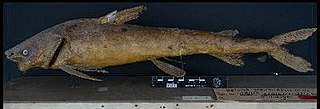
Notarius is a genus of fish in the family Ariidae found in the Atlantic and Pacific Ocean.
Trachinocephalus trachinus, also known as the Indo-Pacific blunt-nose lizardfish is a species of fish in the family Synodontidae found in Indo-Pacific. Although previously synonymized with T. myops, Polanco et al. (2016) demonstrated that the two are distinct in the number of lateral-line scales and other meristics, and resurrected T. trachinus for the Indo-Pacific population. This species grows to a length of 40 centimetres (16 in) TL.
Trachinocephalus gauguini, commonly known as the Curious Scad, is a species of lizardfish in the family Synodontidae. This species was described in 2016 by F.A. Polanco, P.A. Acero, and R. Betancur-R.
















